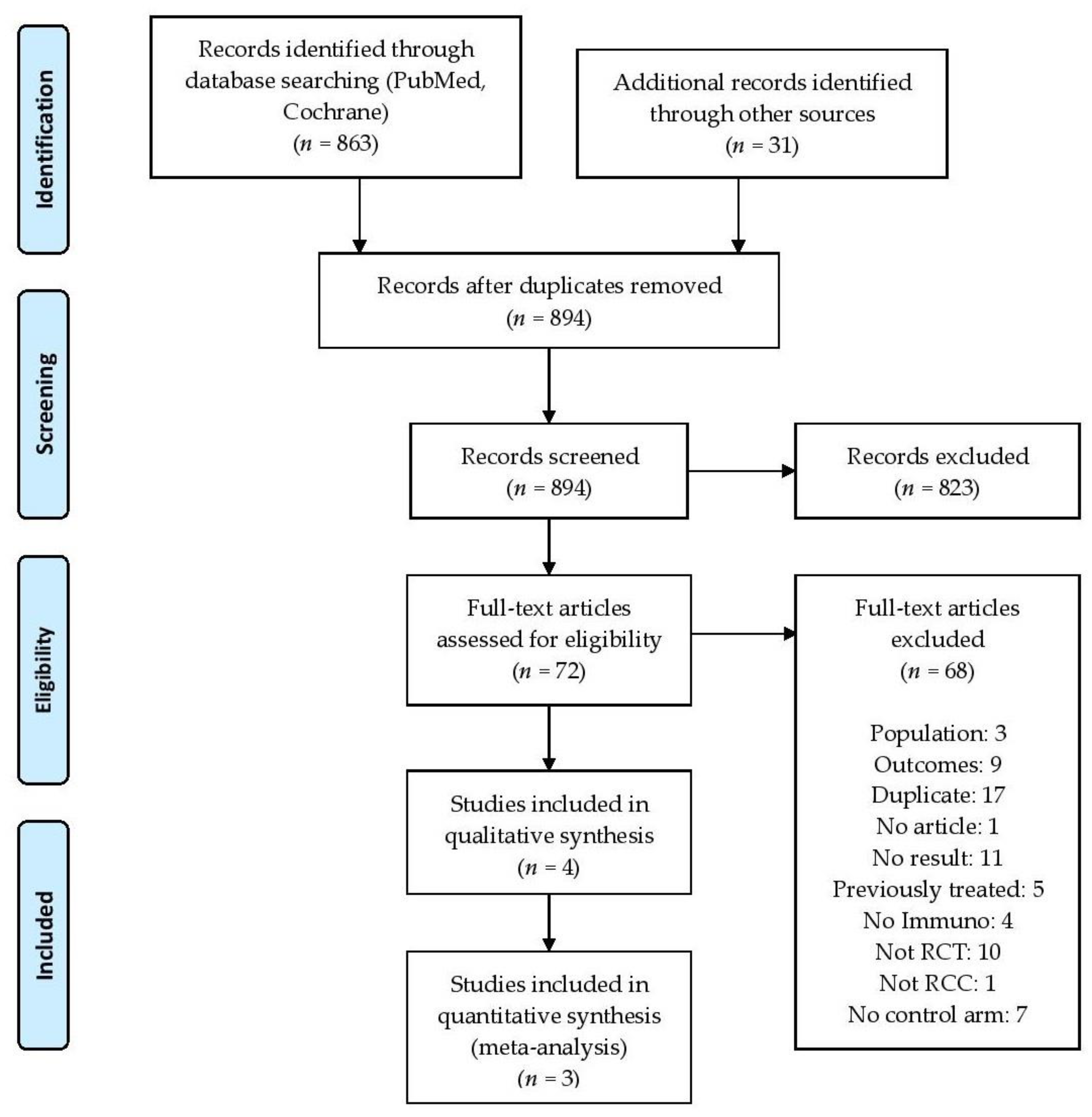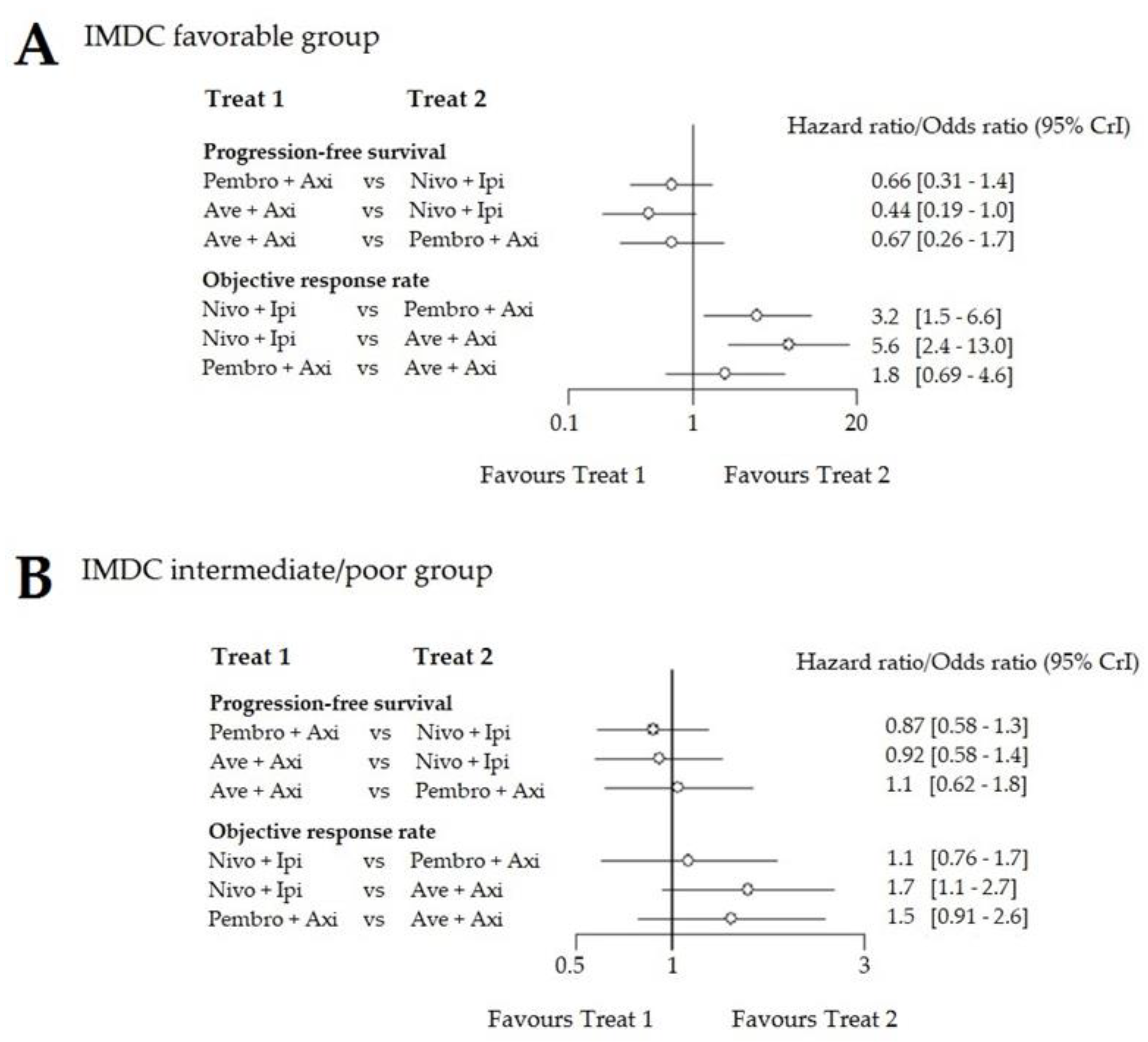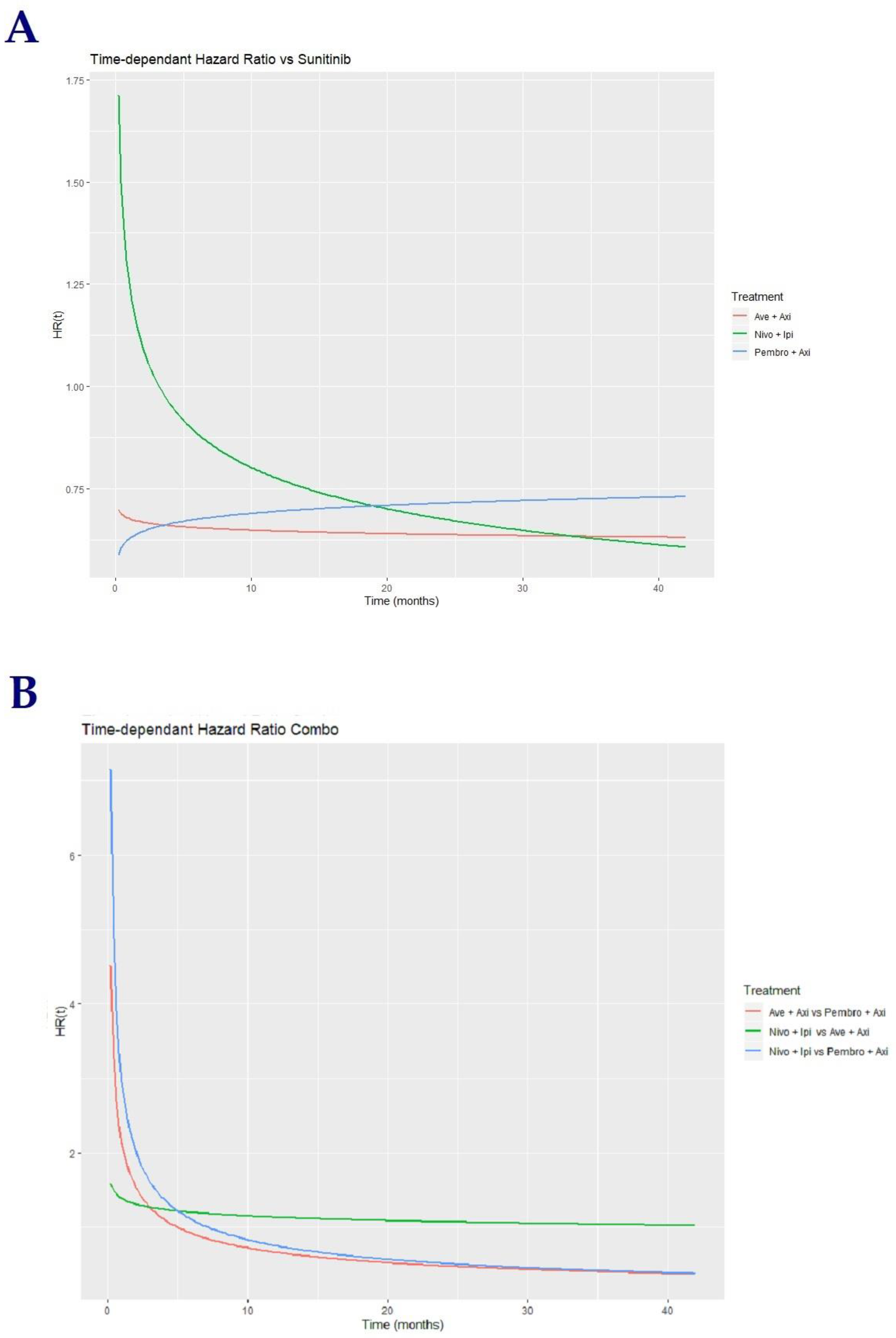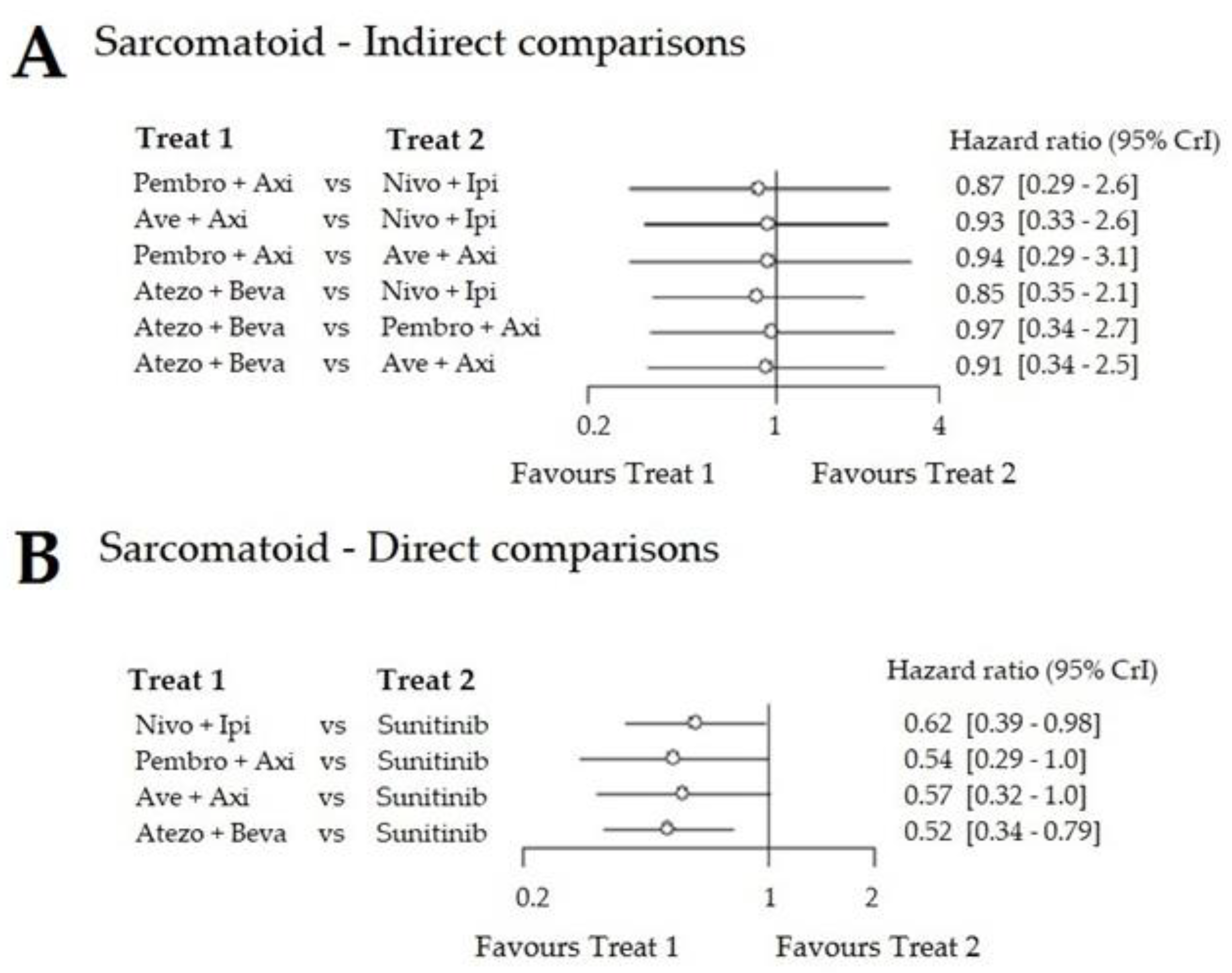Comparative Efficacy of First-Line Immune-Based Combination Therapies in Metastatic Renal Cell Carcinoma: A Systematic Review and Network Meta-Analysis
Abstract
1. Background
2. Methods
2.1. Search Strategy and Selection Criteria
2.2. Statistical Analysis
2.2.1. Contrast-Based Approach
2.2.2. Arm-Based Approach
2.3. Role of the Funding Source
3. Results
3.1. Contrast-Based Approach in Intention-to-Treat Population
3.2. Contrast-Based Approach per IMDC Subgroup
3.3. Arm-Based Approach
3.4. Progression-Free Survival in Intention-to-Treat Population
3.5. Overall Survival in Intention-to-Treat Population
3.6. Exploratory Analysis of PFS in Sarcomatoid Patients
4. Discussion
5. Conclusions
Supplementary Materials
Author Contributions
Funding
Conflicts of Interest
References
- Choueiri, T.K.; Motzer, R.J. Systemic Therapy for Metastatic Renal-Cell Carcinoma. N. Engl. J. Med. 2017, 376, 354–366. [Google Scholar] [CrossRef]
- Iacovelli, R.; Ciccarese, C.; Bria, E.; Bimbatti, D.; Fantinel, E.; Mosillo, C.; Bisogno, I.; Brunelli, M.; Tortora, G.; Porta, C. Immunotherapy versus standard of care in metastatic renal cell carcinoma. A systematic review and meta-analysis. Cancer Treat. Rev. 2018, 70, 112–117. [Google Scholar] [CrossRef]
- Labriola, M.K.; Batich, K.A.; Zhu, J.; McNamara, M.A.; Harrison, M.R.; Armstrong, A.J.; George, D.J.; Zhang, T. Immunotherapy Is Changing First-Line Treatment of Metastatic Renal-Cell Carcinoma. Clin. Genitourin. Cancer 2019, 17, e513–e521. [Google Scholar] [CrossRef] [PubMed]
- Santoni, M.; Massari, F.; Di Nunno, V.; Conti, A.; Cimadamore, A.; Scarpelli, M.; Montironi, R.; Cheng, L.; Battelli, N.; Lopez-Beltran, A. Immunotherapy in renal cell carcinoma: Latest evidence and clinical implications. Drugs Context 2018, 7, 212528. [Google Scholar] [CrossRef] [PubMed]
- Hutson, T.E.; Lesovoy, V.; Al-Shukri, S.; Stus, V.P.; Lipatov, O.N.; Bair, A.H.; Rosbrook, B.; Chen, C.; Kim, S.; Vogelzang, N.J. Axitinib versus sorafenib as first-line therapy in patients with metastatic renal-cell carcinoma: A randomised open-label phase 3 trial. Lancet Oncol. 2013, 14, 1287–1294. [Google Scholar] [CrossRef]
- Choueiri, T.K.; Halabi, S.; Sanford, B.L.; Hahn, O.; Michaelson, M.D.; Walsh, M.K.; Feldman, D.R.; Olencki, T.; Picus, J.; Dakhil, S.; et al. Cabozantinib Versus Sunitinib As Initial Targeted Therapy for Patients With Metastatic Renal Cell Carcinoma of Poor or Intermediate Risk: The Alliance A031203 CABOSUN Trial. J. Clin. Oncol. 2017, 35, 591–597. [Google Scholar] [CrossRef]
- Flippot, R.; Escudier, B.; Albiges, L. Immune Checkpoint Inhibitors: Toward New Paradigms in Renal Cell Carcinoma. Drugs 2018, 78, 1443–1457. [Google Scholar] [CrossRef]
- Motzer, R.J.; Tannir, N.M.; McDermott, D.F.; Frontera, O.A.; Melichar, B.; Choueiri, T.K.; Plimack, E.R.; Barthélémy, P.; Porta, C.; Powles, T.; et al. Nivolumab plus Ipilimumab versus Sunitinib in advanced renal-cell carcinoma. N. Engl. J. Med. 2018, 378, 1277–1290. [Google Scholar] [CrossRef]
- Rini, B.I.; Plimack, E.R.; Stus, V.; Gafanov, R.; Hawkins, R.; Nosov, D.; Pouliot, F.; Alekseev, B.; Soulières, D.; Vynnychenko, I.; et al. Pembrolizumab plus axitinib versus sunitinib for advanced renal-cell carcinoma. N. Engl. J. Med. 2019, 380, 1116–1127. [Google Scholar] [CrossRef] [PubMed]
- Motzer, R.J.; Penkov, K.; Haanen, J.; Rini, B.; Albiges, L.; Campbell, M.T.; Venugopal, B.; Kollmannsberger, C.; Negrier, S.; Lee, J.L.; et al. Avelumab plus axitinib versus sunitinib for advanced renal-cell carcinoma. N. Engl. J. Med. 2019, 380, 1103–1115. [Google Scholar] [CrossRef] [PubMed]
- Rini, B.I.; Powles, T.; Atkins, M.B.; Escudier, B.; McDermott, D.F.; Suarez, C.; Bracarda, S.; Stadler, W.M.; Donskov, F.; Hawkins, R.; et al. Atezolizumab plus bevacizumab versus sunitinib in patients with previously untreated metastatic renal cell carcinoma (IMmotion151): A multicentre, open-label, phase 3, randomised controlled trial. Lancet 2019, 393, 2404–2415. [Google Scholar] [CrossRef]
- Heng, D.Y.; Xie, W.; Regan, M.M.; Harshman, L.C.; Bjarnason, G.A.; Vaishampayan, U.N.; Mackenzie, M.; Wood, L.; Donskov, F.; Rha, S.Y.; et al. External validation and comparison with other models of the International Metastatic Renal-Cell Carcinoma Database Consortium prognostic model: A population-based study. Lancet Oncol. 2013, 14, 141–148. [Google Scholar] [CrossRef]
- Yip, S.M.; Wells, C.; Moreira, R.; Wong, A.; Srinivas, S.; Beuselinck, B.; Porta, C.; Sim, H.-W.; Ernst, D.S.; Yuasa, T.; et al. Checkpoint inhibitors in patients with metastatic renal cell carcinoma: Results from the International Metastatic Renal Cell Carcinoma Database Consortium. Cancer 2018, 124, 3677–3683. [Google Scholar] [CrossRef] [PubMed]
- Escudier, B. Combination Therapy as First-Line Treatment in Metastatic Renal-Cell Carcinoma. N. Engl. J. Med. 2019, 380, 1176–1178. [Google Scholar] [CrossRef] [PubMed]
- Hutton, B.; Salanti, G.; Caldwell, D.M.; Chaimani, A.; Schmid, C.H.; Cameron, C.; Straus, S.; Thoriund, K.; Jansen, J.P.; Mulrow, C.; et al. The PRISMA Extension Statement for Reporting of Systematic Reviews Incorporating Network Meta-analyses of Health Care Interventions: Checklist and Explanations. Ann. Intern. Med. 2015, 162, 777–784. [Google Scholar] [CrossRef]
- Higgins, J.P.; Altman, D.G.; Gøtzsche, P.C.; Jüni, P.; Moher, D.; Oxman, A.D.; Savović, J.; Schulz, K.F.; Weeks, L.; Sterne, J.A.; et al. The Cochrane Collaboration’s tool for assessing risk of bias in randomised trials. BMJ 2011, 343, d5928. [Google Scholar] [CrossRef]
- Salanti, G.; Ades, A.E.; Ioannidis, J.P. Graphical methods and numerical summaries for presenting results from multiple-treatment meta-analysis: An overview and tutorial. J. Clin. Epidemiol. 2011, 64, 163–171. [Google Scholar] [CrossRef]
- Dias, S.; Sutton, A.J.; Ades, A.E.; Welton, N.J. Evidence Synthesis for Decision Making 2. A Generalized Linear Modeling Framework for Pairwise and Network Meta-analysis of Randomized Controlled Trials. Med. Decis. Mak. 2013, 33, 607–617. [Google Scholar] [CrossRef]
- Ouwens, M.J.; Philips, Z.; Jansen, J.P. Network meta-analysis of parametric survival curves. Res. Synth Methods 2010, 1, 258–271. [Google Scholar] [CrossRef]
- Jansen, J.P. Network meta-analysis of survival data with fractional polynomials. BMC Med. Res. Methodol. 2011, 11, 61. [Google Scholar] [CrossRef]
- van Valkenhoef, G.; Kuiper, J. gemtc: Network Meta-Analysis Using Bayesian Methods, R package version 0.8-2; Available online: https://cran.r-project.org/web/packages/gemtc/gemtc.pdf (accessed on 21 June 2020).
- Hahn, A.W.; Klaassen, Z.; Agarwal, N.; Haaland, B.; Esther, J.; Xiang, Y.Y.; Wang, X.; Pal, S.K.; Wallis, C.J. First-line Treatment of Metastatic Renal Cell Carcinoma: A Systematic Review and Network Meta-analysis. Eur. Urol. Oncol. 2019, 2, 708–715. [Google Scholar] [CrossRef] [PubMed]
- Wang, J.; Li, X.; Wu, X.; Wang, Z.; Zhang, C.; Cao, G.; Yan, T. Role of immune checkpoint inhibitor-based therapies for metastatic renal cell carcinoma in the first-line setting: A systematic review and Bayesian network analysis. EBioMedicine 2019, 47, 78–88. [Google Scholar] [CrossRef] [PubMed]






| Study | Treatment | Number of Patients | ORR (95% CI) | Median OS (Months) | Median PFS (Months) | HR OS (95% CI) | HR PFS (95% CI) |
|---|---|---|---|---|---|---|---|
| CheckMate 214 | Sunitinib | 546 | 32% (28–36) | 37.9 | 12.3 | - | - |
| Nivo + Ipi | 550 | 39% (35–43) | NR | 12.4 | 0.71 (0.59–0.86) | 0.85 (0.73–0.98) | |
| Keynote 426 | Sunitinib | 429 | 35.7% (31–40) | NR | 11.1 | - | - |
| Pembro + Axi | 432 | 59% (54–64) | NR | 15.1 | 0.53 (0.38–0.74) | 0.69 (0.57–0.84) | |
| Javelin Renal 101 | Sunitinib | 444 | 25% (22–30) | NR | 8.4 | - | - |
| Ave + Axi | 442 | 51% (47–56) | NR | 13.8 | 0.78 (0.55–1.08) | 0.69 (0.56–0.84) |
| Trial | Treatment | Favorable Prognosis | Intermediate and Poor Prognosis | ||||
|---|---|---|---|---|---|---|---|
| N (%) | HR IC 95% | ORR IC 95% | N (%) | HR IC 95% | ORR IC 95% | ||
| CheckMate 214 | Sunitinib | 124 (23) | 50% | 424 (77) | 29% | ||
| Nivo + Ipi | 125 (23) | 1.23 (0.90–1.69) | 39% | 423 (77) | 0.77 (0.65–0.90) | 42% | |
| Keynote 426 | Sunitinib | 131 (31) | 49.6% | 298 (69) | 29.5% | ||
| Pembro + Axi | 138 (32) | 0.81 (0.53–1.24) | 66.7% | 294 (68) | 0.67 (0.53–0.85) | 55.8% | |
| Javelin Renal 101 | Sunitinib | 96 (22) | 37% | 347 (78) | 22.5% | ||
| Ave + Axi | 94 (22) | 0.54 (0.32–0.91) | 68.1% | 343 (78) | 0.70 (0.53–0.94) | 46.9% | |
© 2020 by the authors. Licensee MDPI, Basel, Switzerland. This article is an open access article distributed under the terms and conditions of the Creative Commons Attribution (CC BY) license (http://creativecommons.org/licenses/by/4.0/).
Share and Cite
Elaidi, R.; Phan, L.; Borchiellini, D.; Barthelemy, P.; Ravaud, A.; Oudard, S.; Vano, Y. Comparative Efficacy of First-Line Immune-Based Combination Therapies in Metastatic Renal Cell Carcinoma: A Systematic Review and Network Meta-Analysis. Cancers 2020, 12, 1673. https://doi.org/10.3390/cancers12061673
Elaidi R, Phan L, Borchiellini D, Barthelemy P, Ravaud A, Oudard S, Vano Y. Comparative Efficacy of First-Line Immune-Based Combination Therapies in Metastatic Renal Cell Carcinoma: A Systematic Review and Network Meta-Analysis. Cancers. 2020; 12(6):1673. https://doi.org/10.3390/cancers12061673
Chicago/Turabian StyleElaidi, Reza, Letuan Phan, Delphine Borchiellini, Philippe Barthelemy, Alain Ravaud, Stéphane Oudard, and Yann Vano. 2020. "Comparative Efficacy of First-Line Immune-Based Combination Therapies in Metastatic Renal Cell Carcinoma: A Systematic Review and Network Meta-Analysis" Cancers 12, no. 6: 1673. https://doi.org/10.3390/cancers12061673
APA StyleElaidi, R., Phan, L., Borchiellini, D., Barthelemy, P., Ravaud, A., Oudard, S., & Vano, Y. (2020). Comparative Efficacy of First-Line Immune-Based Combination Therapies in Metastatic Renal Cell Carcinoma: A Systematic Review and Network Meta-Analysis. Cancers, 12(6), 1673. https://doi.org/10.3390/cancers12061673






